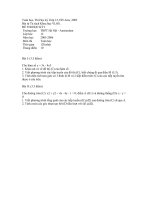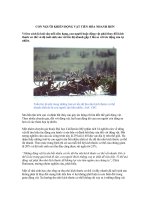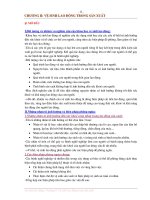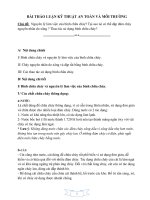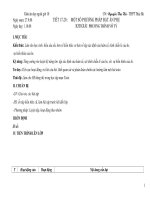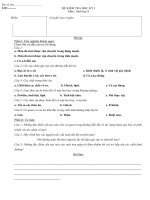Tài liệu Who took Jerell’s iPod? -- An organic compound mystery pdf
Bạn đang xem bản rút gọn của tài liệu. Xem và tải ngay bản đầy đủ của tài liệu tại đây (138.74 KB, 8 trang )
1
Who took Jerell’s iPod? An organic compound mystery
1
Jerell is a 10
th
grade student who works at McDonald’s on the weekends. While on break, Jerell
was studying for his biology test and listening to his new iPod. There were four other workers
taking a break at the same time, each having something different for lunch.
Jerell‘s girlfriend stopped by near the end of his break, and he rushed out to see her and forgot his
iPod and biology book in the break room. When he realized, he hurried back and found only his
biology book and some spilled food. His iPod was gone!
At first Jerell freaked out, but he calmed down when he realized he could use his knowledge of
organic compounds to figure out which of his coworkers left the spilled food on his biology book
while taking his iPod.
What are organic compounds?
Almost all of the food we eat comes from plants and animals. Plants and animals contain mainly
water and organic compounds, which are molecules made by living organisms such as plants or
animals.
1. The table below lists the most common types of organic compounds found in living organisms.
For each type of organic compound, give one or two examples and describe one characteristic,
e.g. whether it is greasy, whether it contains genetic material, whether there is lots of this type of
organic compound in meat or lots in pretzels and potatoes.
Type of Organic
Compound
Examples
Characteristic
of
This Type
of Organic Compound
Carbohydrates
Lipids
Nucleic acids
Proteins
2. Today you will be testing the substances listed in the following table. Predict whether each
substance is an organic compound and if so, what type.
Substance
Do you think this substance is a carbohydrate,
lipid, protein, or none of these?
Vegetable oil
Glucose
Starch from corn or potatoes
Powdered egg whites
Water
1
By Drs. Jennifer Doherty, Ingrid Waldron and Lori Spindler, Department of Biology, University of Pennsylvania, copyright 2012; adapted from
“Identity of Organic Compounds” from Biology Laboratory Manual A from Prentice-Hall; also inspired by “Crime Scene Activity” by Kathy Paris,
Bethel High School .Teachers are encouraged to copy this
Student Handout for classroom use. A Word file, which can be used to prepare a modified version if desired, and Teacher Preparation Notes are
available at
2
What are indicators?
An indicator is a substance that changes color in the presence of a particular type of molecule.
Today you will learn how to use several indicators to test for the presence of carbohydrates and
proteins. You will also use a different type of test for lipids. In your next laboratory period, you will
use these tests to analyze the evidence left at the scene of the crime and find out who spilled the
food on Jerell’s textbook.
Testing for lipids
1. If a food that contains lipids is put on brown paper, it will leave a spot that lets light through. To
test for lipids, divide a piece of a brown paper bag into 5 sections. Label the sections
"vegetable oil", "glucose", "starch", "powdered egg whites", and “water”.
2. In each section, rub a small amount of the substance onto the brown paper. With a paper towel,
rub off any excess that may stick to the paper.
3. Set the paper aside until the spots appear dry—about 10 to 15 minutes. While you are waiting,
answer questions 4 and 5 and then continue with the tests on page 3.
4. Which substance or substances do you expect to test positive for lipids?
5. What is the purpose of testing water for lipids?
6. Why should you test all of the substances for lipids even though you believe that some of them
do not contain lipids?
7. Continue on with the tests on page 3. After all the sections of the brown paper are dry, hold the
paper up to a bright light or window. You will notice that at least one sample has left a spot on
the brown paper that lets light through. This type of spot indicates the presence of lipids.
8. Complete the last column of the data table below. Put a plus for any samples that tested
positive for lipids and a minus for the samples that did not.
Sample
Carbohydrate Tests Protein Test
Lipid
Test
Test strip
color
Glucose
present
Iodine
test
color
Starch
present
Biuret
test
color
Protein
present
Lipid
present
Vegetable oil
Glucose
Starch from corn
or potatoes
Powdered
egg whites
Water
3
Testing for Carbohydrates
1. You will be using chemicals as indicators. You must wear gloves to protect yourself.
2. You will use indicators to test for two common types of carbohydrates: glucose (a specific type
of sugar) and starch. Obtain 5 containers and use masking tape to make labels for each
container. Label the containers "vegetable oil", "glucose", "starch", "egg whites", and “water”.
3. For each container, add a small amount of the substance indicated on the masking-tape label.
Next, add about 2 ml of water to each container. Stir the contents of each container to mix the
substance with the water.
4. To test for glucose you will use a test strip with an indicator pad that changes color in the
presence of glucose. Prepare a piece of paper with the name of each substance and a place to
put the glucose test strip you have used to test that substance. Dip one test strip into each
sample for 1-2 seconds. Remove the strip, put it in the appropriate spot on your labeled paper,
and wait 3 minutes.
5. Which substance or substances do you expect to test positive for glucose?
6. After 3 minutes, look for a color change in each of the glucose test strips and record the color of
each glucose test strip in the data table on page 2. Put a plus next to those samples testing
positive for glucose and a minus for those testing negative.
7. To test for starch you will use iodine as an indicator. In the presence of starch, iodine will
change color from yellow-brown to blue-black. Add 5 drops of iodine solution to each
container. Stir the contents of each container.
CAUTION: Be careful when handling iodine; it can stain hands and clothing.
8. In the data table on page 2, record the color of the iodine solutions. Put a plus next to those
samples testing positive for starch and a minus for those testing negative.
Testing for Proteins
1. Label five clean containers "vegetable oil", "glucose", "starch", "egg whites", and “water”. Add a
small amount of the substance indicated on the label to each container. Add about 2 ml of
water to each container. Stir the contents of each container to mix the substance with the
water.
2. To test for protein you will use Biuret reagent as an indicator. Biuret reagent turns from blue to
purple in the presence of protein. Add 20 drops of biuret reagent to each container. Stir the
contents of each container.
CAUTION: Biuret reagent contains sodium hydroxide, a strong base. Be very careful not
to splash or spill any. If you splash any reagent on yourself, wash it off immediately with
water. Call your teacher for assistance.
3. Record the color of each Biuret solution in the data table on page 2. Put a plus next to those
samples testing positive for protein and a minus for those testing negative.
4. Rinse all ten containers thoroughly.
4
Questions
1. Compare your predictions in the table on page 1 with your test results in the table on page 2.
Were there any differences between your test results and your predictions for what type of
organic compound each substance is? If yes, describe these differences.
If you found any differences between your predictions and your results, what do you think is the
reason for these differences? You may want to check with your teacher, your textbook, or the
nutrition information in the label on each food package to help you interpret your results.
2. Did your test for glucose indicate there was glucose in the starch sample?
Does that mean that there is no glucose in starch? (Hint: Check your textbook or other reliable
source if you do not already know the chemical structure of starch.)
This result shows that the glucose indicator is quite specific. It reacts with glucose dissolved in
water, but it does not react with glucose molecules that are combined into a large organic
compound like starch.
3. Humans get the protein they need from foods, including beans and milk. A bean is a plant seed
which contains a tiny plant embryo, together with food to help the plant embryo grow. Cows and
other mammals produce milk to provide the food their babies need to grow. Seeds and milk
contain proteins, fats, sugars and/or starch.
Explain how the fats, sugars and/or starch contained in seeds or milk are useful for the plant
sprouting from the seed or the baby mammal.
Explain how the protein contained in seeds or milk is useful for the plant sprouting from the
seed or the baby mammal.
5
Part II – Solving the Mystery
Today you and your classmates will solve the mystery of who stole Jerell's iPod by figuring out
which coworker's lunch had the same organic compounds as the evidence Jerell found at the
crime scene.
1. Begin by predicting which types of compounds you expect to find in each type of food.
Food
Do you expect this food to contain
Gluco
se
?
Starch
?
Protein
?
Lipid
?
Pretzel
Butter
Jelly
Fat-free yogurt
Beans
2. Your teacher will assign you a sample or samples to test. Use the procedures described on
pages 2-3 to test the sample or samples for the four types of organic compounds. (The evidence
that Jerell found has been separated into dry and liquid evidence in two separate bottles.)
3. Record your test results in the data table below. For each glucose test strip, record the specific
matching color from the glucose test strip bottle or packet (needed for question 3 on page 8).
4. After you perform the tests, your teacher will collect your data to share with the rest of the class.
Use the data from your classmates to complete the table below.
Food
Carbohydrate Tests Protein Test
Lipid
Test
Test strip
color
Glucose
present
Iodine
test
color
Starch
present
Biuret
test
color
Protein
present
Lipid
present
Pretzel
(crumble into
the container)
Butter
Jelly
Fat-free
yogurt
Beans (mash
into
a paste)
Dry part of
Jerell’s
evidence
Liquid part of
Jerell’s
evidence
5. Compare your predictions in the top table with the results in the bottom table. Were there any
differences? If yes, describe these differences.
6
6. If you found any differences between your predictions and your results, what do you think is the
reason for these differences? You may want to check with your textbook, your teacher, or the
nutrition information in the label on each food package to help you interpret your results.
Who took Jerell’s iPod?
7. The table shows what each worker in the break room was eating while Jerell was studying. Use
the information from the table on the bottom of page 5 to complete this table to show which types
of organic compounds would be in each lunch and which types of organic compounds were found
in the combined liquid + dry evidence.
Worker
in break
room
Lunch he or she was eating Glucose
Starch
Protein
Lipid
Jose Bean burrito with cheese
Ashley Fat-Free Yogurt
Bruce Toast with butter and jelly
Kiara Pretzel
Thief Combined liquid + dry evidence
8. Complete the following table to summarize the evidence and your interpretation of the evidence.
Worker
in break
room
Did
he/she
take
Jerell’s
ipod?
How do you know?
Describe the evidence that supports your conclusion.
Jose
Ashley
Bruce
Kiara
9. Who took Jerell’s iPod? Do you have any doubts about your conclusion? Explain.
7
Review and Discussion Questions
1. To show your understanding of organic compounds, identify the type of organic compound
shown in each diagram and complete the first three columns of the table.
Many large organic compounds are made of multiple repeats of smaller building block compounds.
Starch, proteins, and nucleic acids are examples of this type of organic compound. Circle a
building block in the starch, protein, and nucleic acid figures, and write the name of the building
block in the fourth column.
Type of
Organic
Compound
Functions
Which test is used
to detect this
compound or type
of compound?
Name of
building
block
Diagram of Structure of
Organic Compound
Glucose
Not tested for
8
2. Our bodies are made up of the same types of organic compounds as all other living organisms.
Complete the following sentences by filling in each blank to indicate the function of each type of
molecule in different parts of our body.
Glucose is carried by our blood to all the cells in our body. Our cells use the glucose for
_______________.
Lipids are found in fat cells in our bodies. The fat cells store lipid molecules to be used for
______________ if a person can not get enough food.
Our bodies do not make starch, but we often eat plant foods which contain starch which we
digest into _____________, the building block that is used to make starch.
DNA is a nucleic acid that is found in every cell. DNA carries the ____________
information.
Our muscles contain lots of protein. This protein enables the muscles to _____________.
3. In this activity you have recorded whether an indicator tested positive or negative for each type
of organic compound. We have ignored the fact that different foods contain different amounts of
the various types of organic compounds.
For the five foods listed in the table on the bottom of page 5, list these foods in order from the food
with the most glucose to the food with the least glucose.
Some foods may test positive for glucose, but do not taste sweet. What is a possible explanation?
Some foods may taste sweet, but have very little glucose. What is a possible explanation?
4. Sophisticated laboratory analysis of pretzels, fat-free yogurt, and beans indicate that all three of
these foods contain at least a little bit of lipid and protein.
Did you and your classmates get positive tests for lipids and proteins in all three of these foods?
(Check the bottom table on page 5.)
If any of your class’s tests for lipids and proteins in these foods were not positive, what reason or
reasons could account for these negative findings?
